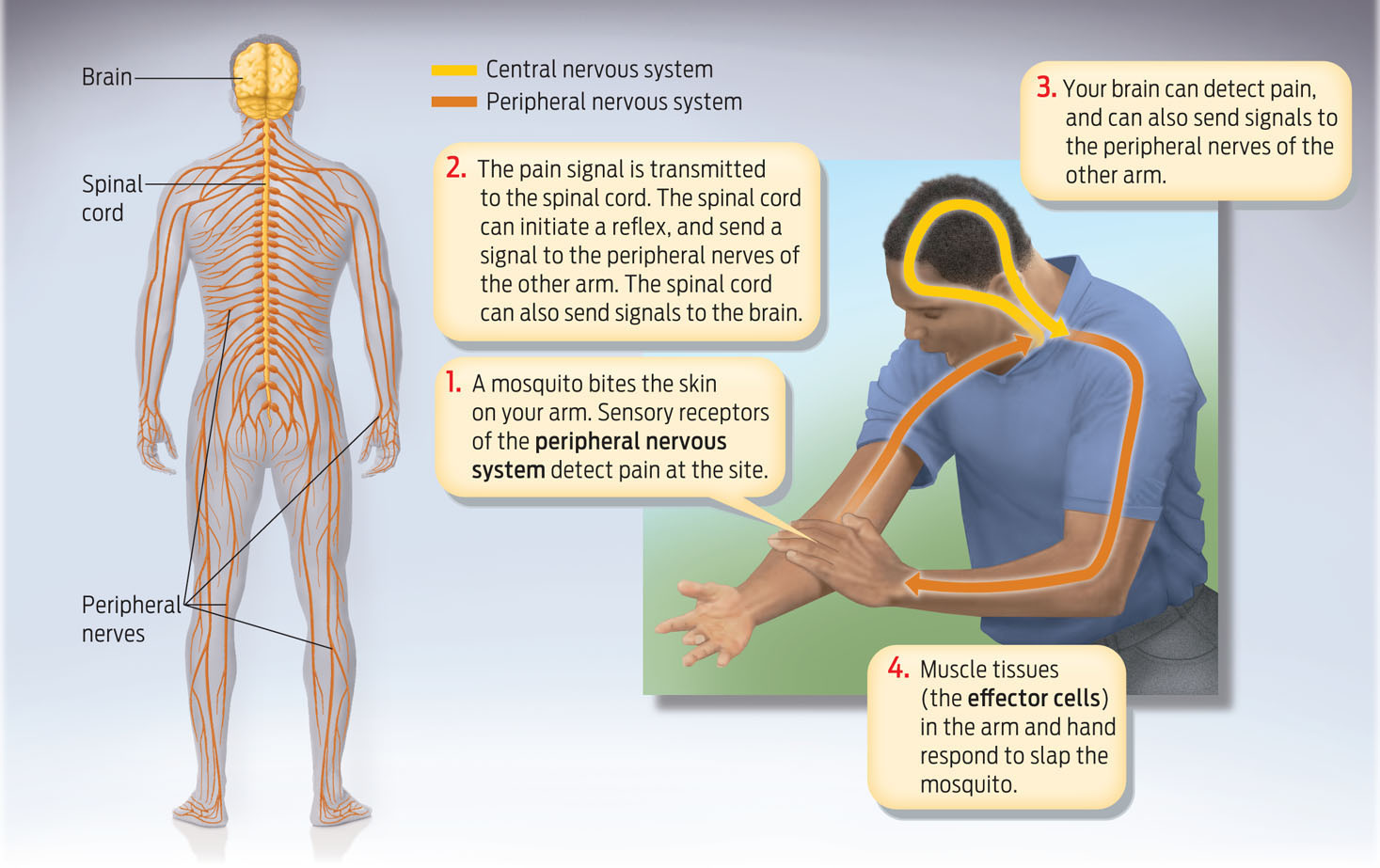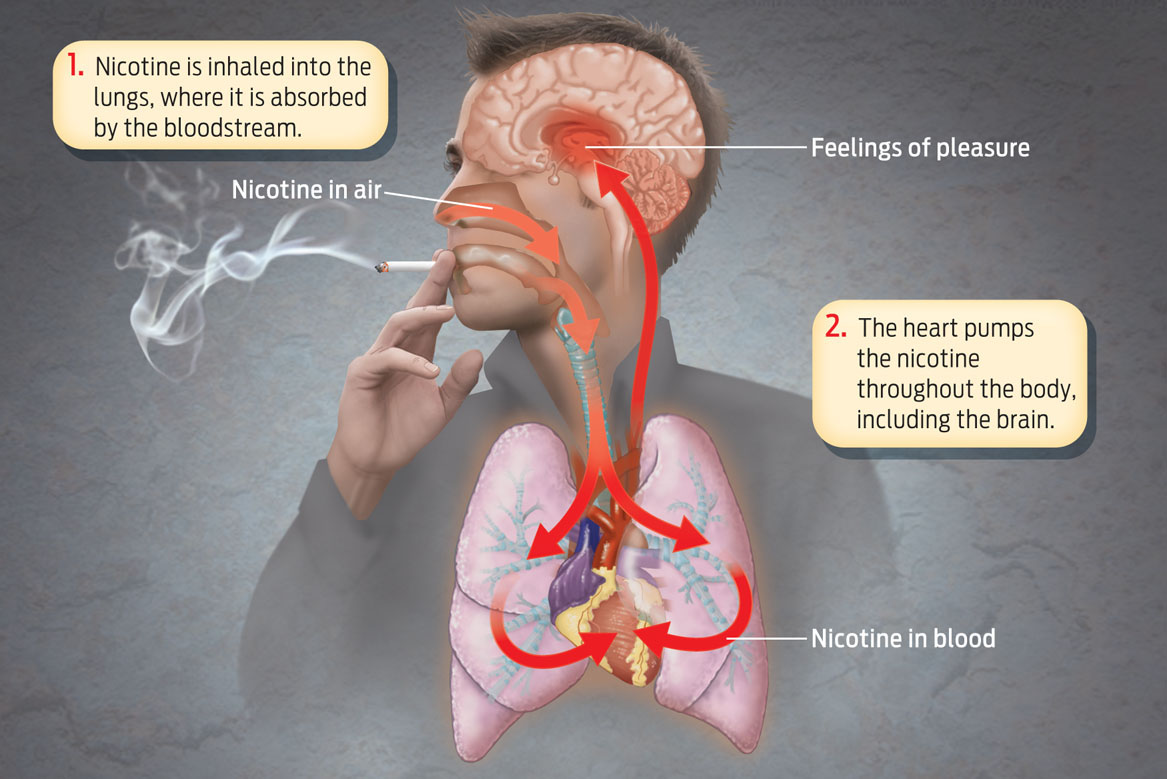ADDICTION AND THE BRAIN
BRAIN An organ of the central nervous system that integrates and coordinates virtually all functions of the body.
Despite a massive public health campaign aimed at curbing the dangerous habit, cigarette smoking remains a common practice in this country. Today, in 2013, about 22% of Americans smoke tobacco regularly, according to the National Institute on Drug Abuse (NIDA), down from about 45% in 1955. These numbers testify to tobacco’s addictive potential.
The component in tobacco that makes cigarettes addictive is the chemical nicotine. When a person smokes, nicotine floods the lungs, where it is absorbed into the bloodstream. Once in the bloodstream, nicotine travels quickly throughout the body, reaching the brain within 8 seconds after tobacco smoke is inhaled. Chewing tobacco also contains nicotine, which the body absorbs through the mucous membranes that line the mouth.
Nicotine is addictive because it stimulates feelings of pleasure in the brain. The brain is the master coordinator of the body, controlling virtually all of the body’s activities, including sensation, movement, intellect, and just about all involuntary actions. The brain is also the seat of memory. Pleasurable experiences recorded in our memories serve as motivation; we tend to seek out the same pleasurable experiences over and over. Ultimately, the decision to smoke a cigarette, or to carry out any other behavior, is made in the brain (INFOGRAPHIC 29.1).
NERVE A bundle of specialized cells that transmit information.
SPINAL CORD A bundle of nerve fibers, contained within the bony spinal column, that transmits information between the brain and the rest of the body.
The brain doesn’t act in isolation: it communicates with the rest of the body, sending out and receiving signals to coordinate our many activities. When we decide to reach for a cigarette, for example, our brain sends a signal to our arm. These signals travel along nerves–long fibers made up of specialized cells and supportive tissue that transmit signals through the nervous system. A major collection of nerves is the spinal cord, which extends from the base of the brain down to the lower back and is contained in and protected by our bony spinal column. Together, the brain and the spinal cord make up the central nervous system (CNS). Nerves that travel from spinal cord to distant body sites, like fingers, toes, and heart muscle, compose the peripheral nervous system (PNS). The peripheral nervous system includes all nervous tissue outside the brain and spinal cord leading to and from our limbs and organs.
CENTRAL NERVOUS SYSTEM (CNS) The brain and the spinal cord.
PERIPHERAL NERVOUS SYSTEM (PNS) All the nervous tissue outside the central nervous system which transmits signals from the CNS to the rest of the body.
The CNS and the PNS work together to sense and respond to stimuli in the environment. Sensory receptors of the PNS in our ears, our eyes, and in our skin, for example, enable us to sense changes in our environment–a sudden loud noise, for example, or the sting of a mosquito. These stimuli are transmitted to the brain and spinal cord, which assess the incoming signals and trigger an appropriate response, such as a reflex. The reflex is carried out by effector tissues such as muscles that allow us to respond–by jumping or swatting our arm, for example. Peripheral nervous tissue in other organs, including the lungs, heart, and digestive organs, keeps our bodies operating without conscious thought. The nervous system allows us to perceive and understand the world around us and to translate thought into action (INFOGRAPHIC 29.2).
In-Class Activity
Click here to access Application Activities: Neuro-Addiction specifically designed for chapter 29.
The nervous system has two main branches: the central nervous system (yellow) and the peripheral nervous system (orange). The central nervous system consists of the brain and spinal cord. The rest of the nervous system is the peripheral nervous system, which connects the CNS to the rest of the body.

